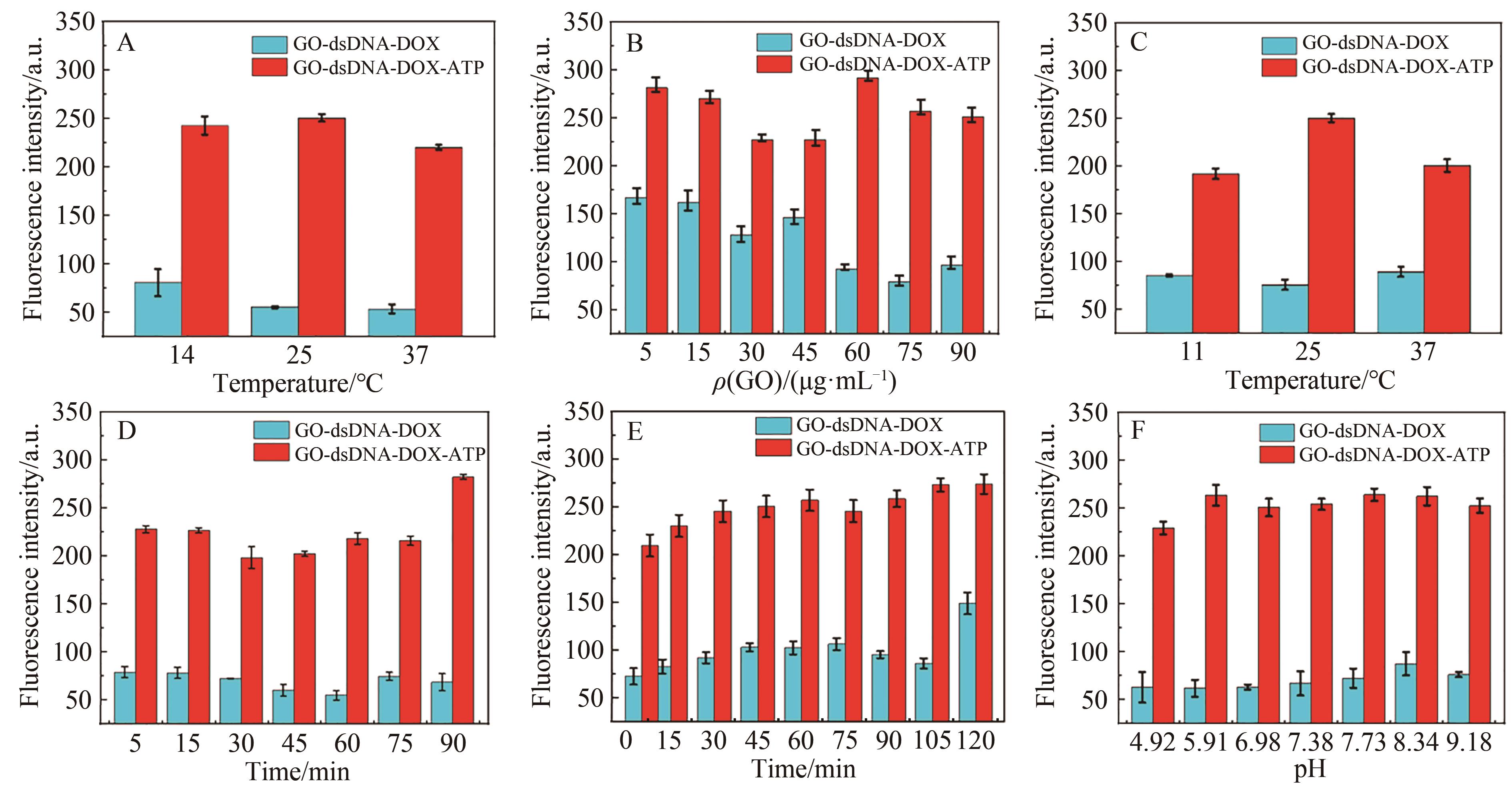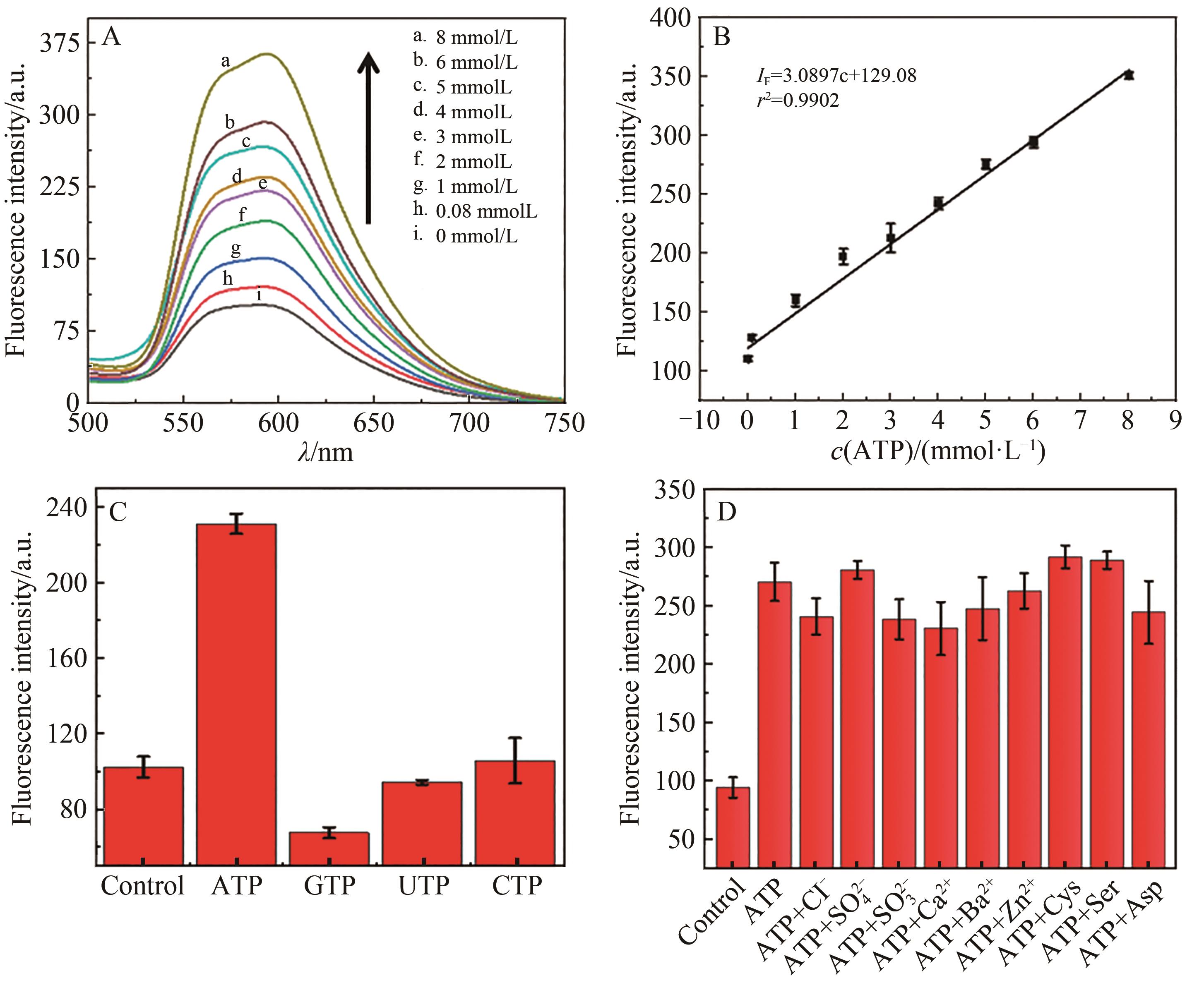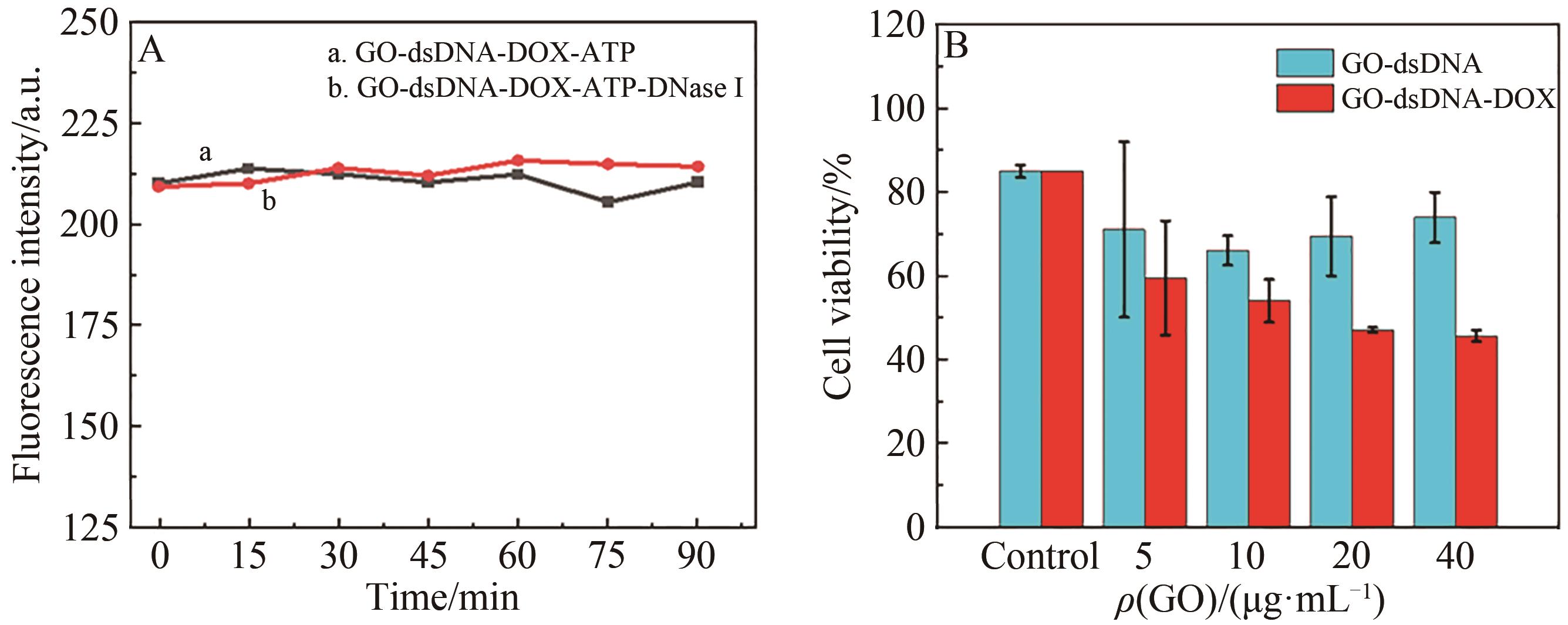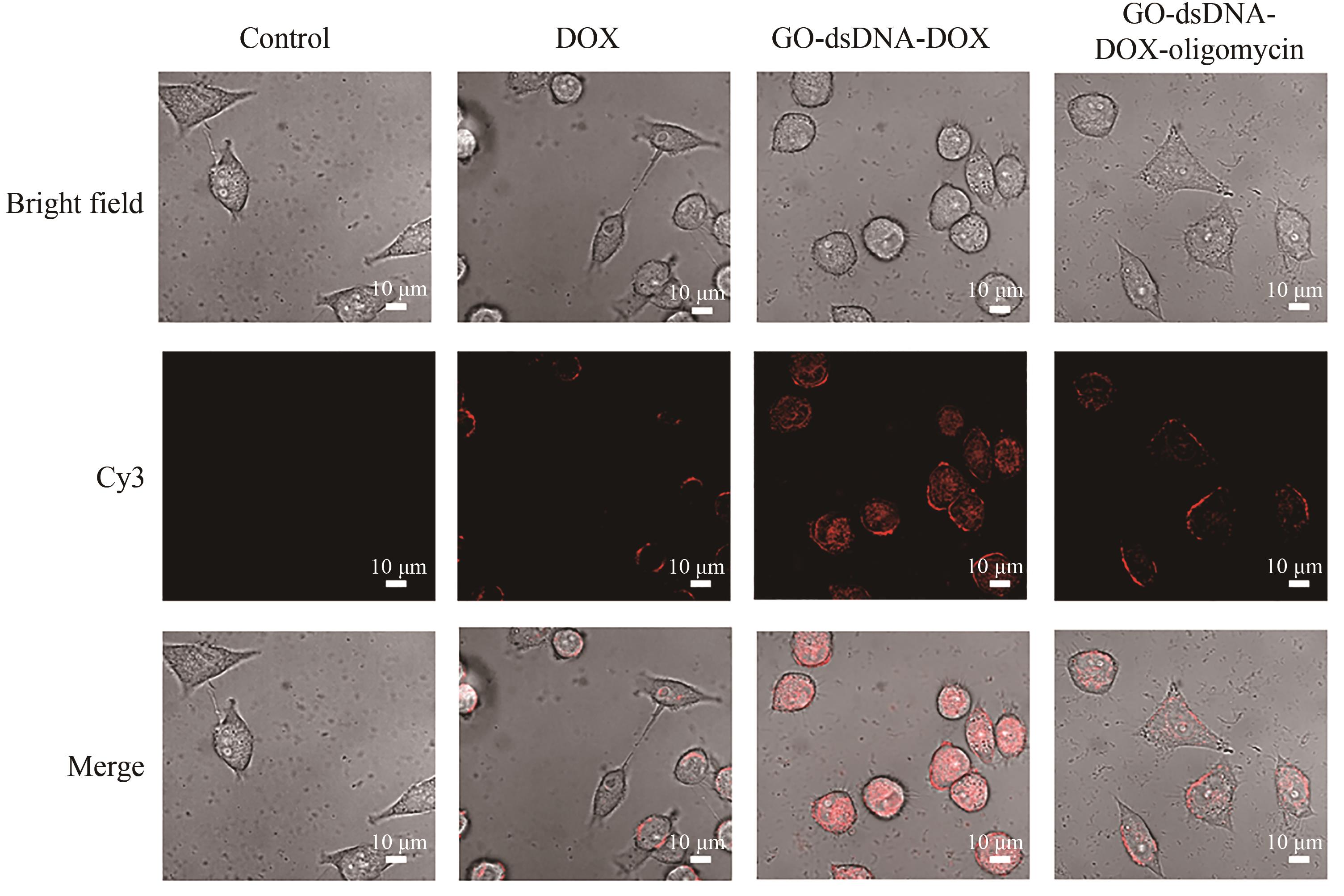
Chinese Journal of Applied Chemistry ›› 2024, Vol. 41 ›› Issue (1): 118-127.DOI: 10.19894/j.issn.1000-0518.230012
• Full Papers • Previous Articles Next Articles
Construction of Graphene Oxide-DNA Nanoprobe for Adenosine 5-Triphosphate Detection and Drug Delivery
Yue ZHANG, Rui LIANG, Can-Nan ZHAO, Chun-Mei LI( )
)
- College of Pharmaceutical Sciences,Southwest University,Chongqing 400715,China
-
Received:2023-01-19Accepted:2023-04-05Published:2024-01-01Online:2024-01-30 -
Contact:Chun-Mei LI -
About author:licm1024@swu.edu.cn
-
Supported by:the National Natural Science Foundation of China (No.?22074124)?, the Natural Science Foundation of Chongqing (No.?CSTB2022NSCQ-MSX0521) and Chongqing Municipal Training Program of Innovation and Entrepreneurship for Undergraduates(S202210635349)
CLC Number:
Cite this article
Yue ZHANG, Rui LIANG, Can-Nan ZHAO, Chun-Mei LI. Construction of Graphene Oxide-DNA Nanoprobe for Adenosine 5-Triphosphate Detection and Drug Delivery[J]. Chinese Journal of Applied Chemistry, 2024, 41(1): 118-127.
share this article
Add to citation manager EndNote|Ris|BibTeX
URL: http://yyhx.ciac.jl.cn/EN/10.19894/j.issn.1000-0518.230012

Fig.2 Investigation on the ATP response and salt stability of GO-dsDNA-DOX nanoprobe. (A) Fluorescence spectra of GO-dsDNA-DOX before or after reaction with ATP; (B) Zeta potential analysis of GO-dsDNA-DOX before or after reaction with ATP; (C) Salt stability of GO-dsDNA-DOX

Fig.3 Optimization of experiment conditions. (A) DOX loading temperature; (B) Concentration of GO; (C) Adsorption temperature of GO; (D) Adsorption time of GO; (E) ATP reaction time; (F) pH of buffer (Error bars represented standard deviations of three repetitive experiments)

Fig.4 Detection, specificity and anti-interference of GO-dsDNA-DOX probe for ATP assay. (A) Fluorescence response of the GO-dsDNA-DOX to different ATP concentrations; (B) The linear relationship between fluorescence intensity and ATP concentrations; (C) Specificity for the detection of ATP; (D) Anti-interference of probe (Error bars represented standard deviations of three repetitive experiments)

Fig.5 Analysis of nuclease stability and cytotoxicity of GO-dsDNA-DOX probe. (A) Investigation on stability of probe against nuclease; (B) Cytotoxicity of MCF-7 cells incubated with different concentrations of probes (Error bars represented standard deviations of three repetitive experiments)

Fig.6 Fluorescence images of the GO-dsDNA-DOX in MCF-7 cells. Line 1: control cells; Line 2: cells incubated with DOX; Line 3: cells incubated with GO-dsDNA-DOX; Line 4: cells incubated with GO-dsDNA-DOX-oligomycin
| 1 | ZHANG P, GUO X, GAO J, et al. A dual-control strategy by phosphate ions and local microviscosity for tracking adenosine triphosphate metabolism in mitochondria and cellular activity dynamically[J]. ACS Sens, 2021, 6(11): 4225-4233. |
| 2 | VELASQUEZ S, LASQUEZ L, VALDEBENITO S, et al. Circulating levels of ATP is a biomarker of HIV cognitive impairment[J]. Ebiomedicine, 2020, 51: 152-169. |
| 3 | DI Z, ZHAO J, CHU H, et al. An acidic-microenvironment-driven DNA nanomachine enables specific ATP imaging in the extracellular milieu of tumor[J]. Adv Mater, 2019, 31: 1901885. |
| 4 | MIMONO F, TATSNMI K, SHIMIZU S, et al. Exploitation of elevated extracellular ATP to specifically direct antibody to tumor microenvironment[J]. Cell Rep, 2020, 33(12): 108542. |
| 5 | SCHIFMAN R B, WIEDEN M, BROOKER J, et al. Bacteriuria screening by direct bioluminescence assay of ATP[J]. J Clin Microbiol, 1984, 20(4): 644-648. |
| 6 | SANTIANA J J, SAWANT S S, ROUGE J L. Multi-layered stimuli responsive DNA micelles for the stepwise controlled release of small molecules[J]. J Mater Chem B, 2022, 10(37): 7518-7526 |
| 7 | FANG B Y, YAO M H, WANG C Y, et al. Detection of adenosine triphosphate in HeLa cell using capillary electrophoresis-laser induced fluorescence detection based on aptamer and graphene oxide[J]. Colloid Surface B, 2016, 140: 233-238. |
| 8 | XU Y, KANG Q, YANG B, et al. A nanoprobe based on molybdenum disulfide nanosheets and silver nanoclusters for imaging and quantification of intracellular adenosine triphosphate[J]. Anal Chim Acta, 2020, 1134: 75-83. |
| 9 | TOPKAYA S N, CETIN A E. Electrochemical aptasensors for biological and chemical analyte detection[J]. Electroanalysis, 2021, 33(2): 277-291. |
| 10 | LV W X, FU B Q, LI M L, et al. Determination of IC50 values of anticancer drugs on cells by D2O-single cell Raman spectroscopy[J]. Chem Commun, 2022, 58(14): 2355-2358. |
| 11 | LIN C S, YAO Q H, CHEN X. A label-free electrochemiluminescent sensor for ATP detection based on ATP-dependent ligation[J]. Talanta, 2016, 154: 492-497. |
| 12 | ZHENG X, PENG R, JIANG X, et al. Fluorescence resonance energy transfer-based DNA nanoprism with a split aptamer for adenosine triphosphate sensing in living cells[J]. Anal Chem, 2017, 89(20): 10941-10947. |
| 13 | LI L L, LV W Y, WANG Y, et al. DNA logic nanodevices for real-time monitoring of ATP in lysosomes[J]. Anal Chem, 2021, 93(46): 15331-15339. |
| 14 | KRISSANAPRASIT A, KEY C M, PONTULA S, et al. Self-assembling nucleic acid nanostructures functionalized with aptamers[J]. Chem Rev, 2021, 121(22): 13797-13868. |
| 15 | STEFAN G, HOSU O, DEWAEL K, et al. Aptamers in biomedicine: selection strategies and recent advances[J]. Electrochim Acta, 2021, 376: 137994. |
| 16 | LIU M T, MA W J, LI Q S, et al. Aptamer-targeted DNA nanostructures with doxorubicin to treat protein tyrosine kinase 7-positive tumours[J]. Cell Prolif, 2019, 52: e12511. |
| 17 | LI L L, LV W Y, HUANG C Z, et al. DNA logic nanodevices for real-time monitoring of ATP in lysosomes[J]. Anal Chem, 2021, 93(46): 15331-15339. |
| 18 | CHAI X, FAN Z, LI L L, et al. A redox-activatable DNA nanodevice for spatially-selective, and gated imaging of ATP and glutathione in mitochondria[J]. Nano Lett, 2021, 21(23): 10047-10053. |
| 19 | RAZAQ A, BIBI F, ZHENG X X. Review on graphene-, graphene oxide-, reduced graphene oxide-based flexible composites: from fabrication to applications[J]. Materials, 2022, 15(3): 1012. |
| 20 | DAVID L D, DOLORES M M, VELAZQUEZ M M, et al. The behavior of graphene oxide trapped at the air water interface[J]. Adv Colloid Interfae, 2020, 286: 102312. |
| 21 | WEI W X, WANG L L, HUANG Q L, et al. Controlled synthesis of biocompatible rGO@CD@Au nanocomposites for trace detection for doxorubicin by Raman imaging spectroscopy[J]. J Alloys Compd, 2019, 783: 37-43. |
| 22 | LI Y L, LI N, TANG B, et al. Reversing multidrug resistance by multiplexed gene silencing for enhanced breast cancer chemotherapy[J]. ACS Appl Mater Interfaces, 2018, 10(18): 15461-15466. |
| 23 | TAN X, CHEN T, XIONG X, et al. Semiquantification of ATP in live cells using nonspecific desorption of DNA from graphene oxide as the internal reference[J]. Anal Chem, 2012, 84: 8622-8627. |
| 24 | LIU Z, CHEN S, LIU B, et al. Intracellular detection of ATP using an aptamer beacon covalently linked to graphene oxide resisting nonspecific probe displacement[J]. Anal Chem, 2014, 86(20): 12229-12235. |
| 25 | HOBZA P. Stacking interactions[J]. Phys Chem Chem Phys, 2008, 10(19): 2581-2583. |
| 26 | VARGHESE N, MOGERA U, DAS A, et al. Binding of DNA nucleobases and nucleosides with grapheme[J]. Chem Phys Chem, 2009, 10(1): 206-210. |
| 27 | XIAO X, LI Y F, HUANG C Z, et al. A novel graphene oxide amplified fluorescence anisotropy assay with improved accuracy and sensitivity[J]. Chem Commun, 2015, 51(89): 16080-16083. |
| 28 | JIANG Y J, WANG N, CHENG F, et al. Dual energy transfer-based DNA/graphene oxide nanocomplex probe for highly robust and accurate monitoring of apoptosis-related microRNAs[J]. Anal Chem, 2020, 92 (17): 11565-11572. |
| 29 | MO R, JIANG T Y, GU Z, et al. Enhanced anticancer efficacy by ATP-mediated liposomal drug delivery[J]. Angew Chem Int Ed, 2014, 53(23): 5815-5820. |
| 30 | OBAYASHI H, TAKASE S, NISHIMURA H, et al. RNAi screening reveals a synthetic chemical-genetic interaction between ATP synthase and PFK1 in cancer cells[J]. Cancer Sci, 2023, 114(4): 1-9. |
| [1] | Xiao-Ying LIU, Fang-Min CHEN, Hui-Juan ZHANG, Hai-Jun YU. Advancement of Cyclodextrin-Based Host-Guest Drug Delivery System for Antitumor Therapy [J]. Chinese Journal of Applied Chemistry, 2023, 40(7): 964-975. |
| [2] | Xin-Tao XIE, Sang-Ni JIANG, Xi-Fei YU. Selective Binding pH Responsive Liposomes with Phenylboronic Acid for Drug Delivery [J]. Chinese Journal of Applied Chemistry, 2023, 40(6): 860-870. |
| [3] | Wei-Na HAO, Chao ZHOU, Hai-Ping DI, Lin-Hong DENG. Preparation and Characterization of Graphene Oxide-Hyaluronic Acid-Polyethylene Glycol Composite Supramolecular Hydrogel [J]. Chinese Journal of Applied Chemistry, 2023, 40(12): 1672-1681. |
| [4] | Fang XIA, Zi-Ying XU, He WANG, Yu-Fang HE. Graphene Oxide Characterization Based on Bibliometrics [J]. Chinese Journal of Applied Chemistry, 2023, 40(10): 1448-1455. |
| [5] | Yue-Hua ZHAO, Da-Peng WANG. Coadsorption Kinetics of Amino‑Functionalized Graphene Oxide and Fatty Acids at the Water/Oil Interface [J]. Chinese Journal of Applied Chemistry, 2022, 39(8): 1274-1284. |
| [6] | Shan SHAO, Jian ZHANG, Kai-Qiang DENG, Jie YANG, Shao-Ming YANG. Detection of Dopamine by Enzyme‑Free Sensor Constructed by Nickel‑Cobalt Bimetallic‑porphyrin Organic Framework Composites [J]. Chinese Journal of Applied Chemistry, 2022, 39(7): 1098-1107. |
| [7] | Qing-Fang NIU, Xin AI, Yi-Xuan WANG, Fang-Jiu HE, Bi LUO, Wen-Ting LIANG, Chuan DONG. Synthesis of Three‑Dimensional Reduced Graphene Oxide/β‑Cyclodextrin Complex and Its Electrochemical Detection of Levofloxacin in Water [J]. Chinese Journal of Applied Chemistry, 2022, 39(7): 1129-1137. |
| [8] | Yi-Xin XU, Shuang WANG, Jing QUAN, Wan-Ting GAO, Tian-Qun SONG, Mei YANG. Preparation of Molybdenum Disulfide Quantum Dots/Reduced Graphene Oxide Composites and Their Photocatalytic Degradation of Organic Dyes, Tetracyclines and Cr(VI) [J]. Chinese Journal of Applied Chemistry, 2022, 39(5): 769-778. |
| [9] | Hui DU, Chen-Yang YAO, Hao PENG, Bo JIANG, Shun-Xiang LI, Jun-Lie YAO, Fang ZHENG, Fang YANG, Ai-Guo WU. Applications of Transition Metal⁃doped Iron⁃based Nanoparticles in Biomedicine [J]. Chinese Journal of Applied Chemistry, 2022, 39(3): 391-406. |
| [10] | CHENG Cui-Lin, MA Jia-Pei, WANG Wei-Chen, WANG Bo-Yang, WANG Zhen-Yu. Application of Electrospinning Technology of Natural Products in Biomedicine [J]. Chinese Journal of Applied Chemistry, 2021, 38(6): 605-614. |
| [11] | LIU Wen-Bin, YANG Sha-Sha, HUANG Guo-Lin, FAN Li-Jiao, XIE Yu-Ming. Synthesis of Phosphorylated Xanthan Gum/Graphene Oxide and Its Selective Adsorption of Uranium [J]. Chinese Journal of Applied Chemistry, 2021, 38(6): 658-667. |
| [12] | ZHANG Ya-Jing, WANG Xiao-Hui, XU Ya-Juan, LIU Wen-Shu, ZHAO Li-Hui. Preparation of Graphene Nano-Drug Carrier System and Its Killing Effect on Tumor Cells [J]. Chinese Journal of Applied Chemistry, 2021, 38(6): 693-703. |
| [13] | XIAO Haimei, CAI Lei, ZHANG Zhaohui, CHEN Shan, ZHOU Shu, FU Jinli. Preparation of Ion-Imprinted Polymers Based on Magnetic Graphene Oxide/MIL-101 (Cr) and Selective Adsorption of Cu(Ⅱ) and Pb(Ⅱ) [J]. Chinese Journal of Applied Chemistry, 2020, 37(9): 1076-1086. |
| [14] | GAO Siheng, YANG Yu, WU Jinling, QIN Lixia, KANG Shizhao, LI Xiangqing. Preparation and Photoelectric Performance of Graphene Oxide/Ultrafine Silver Composite [J]. Chinese Journal of Applied Chemistry, 2020, 37(8): 923-929. |
| [15] | WANG Wei, LI Juan, BAI Ru, HAN Zhen, FENG Xuewei, SUN Yue. Preparation of Au/Polyacrylamide@Graphene Oxide/Nano-palladium Electrode via Metal-Free Visible-Light-Induced Atom Transfer Radical Polymerization and Its Detection of Ethanol [J]. Chinese Journal of Applied Chemistry, 2020, 37(5): 595-603. |
| Viewed | ||||||
|
Full text |
|
|||||
|
Abstract |
|
|||||
